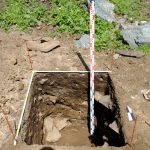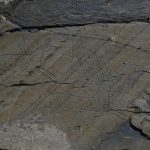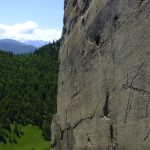Archaeological research in Altai
From 12 May to 9 June, within the framework of the State Program of the Republic of Tatarstan «Preservation of the national identity of the Tatar people», the Institute of Archeology named after A.Kh. Khalikov of the Tatarstan Academy of Sciences conducted archaeological surveys in the Ongudai district of the Republic of Altai. The aim of the expedition was to search for new settlement monuments and study well-known rock paintings.
The first object of study was the Ak-Kaya site, located in the valley of the Nizhnyaya Karasu River. In 2021, a local resident found on his livestock area a fragment of a grinding stone and a stone tile with engraved hunting scenes dating from the early Middle Ages. These findings, previously introduced into scientific circulation by the senior research fellow at the Institute of Archaeology of the Tatarstan Academy of Sciences A.U. Urbushev, served as the basis for exploration. In order to discover new artifacts and determine the type of site, a test pit was laid, but it did not reveal any materials. This made it possible to exclude the possibility of the existence of a settlement or campsite in this place.
The second area of archaeological exploration was the valley of the Karakol River. In the area of Eki Emchek, battle and hunting scenes previously unknown to science were discovered, engraved on the rock surface. A total of 20 images have been recorded, some of which have been partially lost due to stone delamination. In another area, Tonosh, on the southern slope of one of the spurs of the Terekta Range, early medieval inscriptions consisting of 38 runes were found. The location of these inscriptions was previously recorded by an expedition of the Gorno-Altai Scientific Research Institute of History, Language and Literature, but researchers were unable to make a quality copy of the inscriptions. Since 2023, the work conducted by the Institute of Archaeology named after A.Kh. Khalikov in this valley has allowed to rediscover the inscriptions, which will make it possible to read them and expand the corpus of studied epigraphic monuments of Altai.





